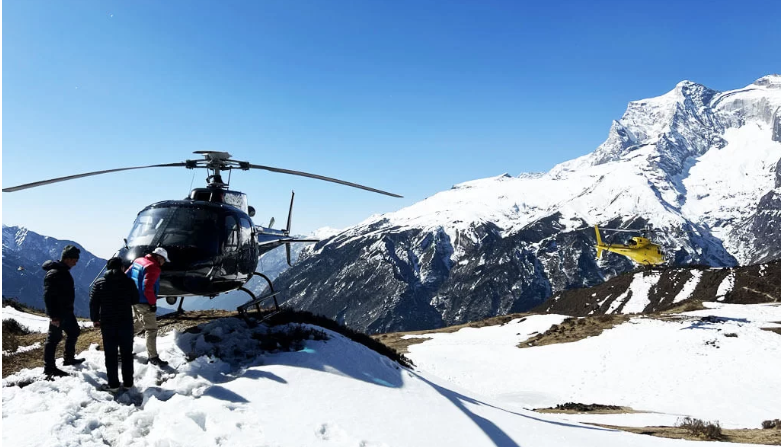The allure of Mount Everest is timeless. Towering at 8,848.86 meters (29,031.7 ft), it captures the imagination of adventurers, trekkers, and nature lovers from across the globe. While the traditional trek to Everest Base Camp (EBC) remains one of the most iconic multi-day adventures, not everyone has the time, physical capability, or desire for a long and strenuous hike. Enter the Everest Base Camp Helicopter Tour — a luxury alternative offering a breathtaking bird’s-eye view of the Himalayas with minimal physical exertion and maximum visual impact.
This once-in-a-lifetime experience is ideal for travelers who seek the thrill and majesty of the Everest region in just a few hours, without compromising on comfort or safety.
What is an Everest Base Camp Helicopter Tour?
An Everest Base Camp Helicopter Tour is a scenic flight experience that departs from Kathmandu or Lukla, soaring above the Himalayas, flying close to Mount Everest, and landing at or near the EBC or Kala Patthar. The total duration of the tour typically ranges from 4 to 5 hours, including multiple landings and panoramic aerial views of iconic Himalayan peaks.
The helicopter tour is specifically designed for those who want:
- A shorter alternative to the 10–14 day Everest trek.
- A luxury adventure with dramatic Himalayan views.
- To visit Everest Base Camp or Kala Patthar without high-altitude trekking.
Highlights of the Helicopter Tour to Everest Base Camp
1. Panoramic Aerial Views
From the moment you lift off, you’re treated to stunning vistas of Kathmandu Valley, lush green hills, and gradually rising snow-capped peaks. As you approach the Khumbu region, the scenery becomes increasingly dramatic, revealing mountain giants such as:
- Mount Everest (8,848.86 m)
- Lhotse (8,516 m)
- Makalu (8,481 m)
- Cho Oyu (8,188 m)
- Ama Dablam (6,812 m)
2. Landing at Kala Patthar
Most helicopter tours include a landing at Kala Patthar (5,545 meters), a well-known vantage point that offers the best close-up view of Mount Everest — something even trekkers may not always enjoy due to weather or altitude sickness.
The brief landing (usually 10–15 minutes) allows for photos, videos, and a chance to breathe in the thin, crisp air at one of the world’s highest viewpoints.
3. Breakfast with a View
Many premium helicopter tours include a stop at Hotel Everest View, the world’s highest luxury hotel (3,880 m), for breakfast or tea. The terrace offers awe-inspiring views of Everest and the surrounding Himalayan range — an indulgent and surreal experience.
4. Fly Over the Khumbu Glacier & Tengboche Monastery
You’ll get a unique aerial perspective of the Khumbu Icefall, crevasses, glacial rivers, and iconic landmarks like Tengboche Monastery — a sacred site for Sherpas — all without trekking the rugged trails.
Best Time for Everest Base Camp Helicopter Tours
The ideal seasons for helicopter tours to Everest are:
- Spring (March to May): Clear skies, blooming rhododendrons, and warm weather.
- Autumn (September to November): Stable weather, excellent visibility, and stunning views.
Although winter flights are possible, extreme cold and potential snowfall may limit visibility and landing options. Monsoon season (June to August) is generally avoided due to heavy rain and poor visibility.
Is the Tour Safe?
Yes, Everest helicopter tours are considered safe, provided you fly with a reputable operator. The helicopters are operated by trained, certified pilots experienced in mountain flying and high-altitude landings.
Some key safety aspects include:
- Oxygen cylinders onboard.
- Limited passenger count for high-altitude landings.
- Regular helicopter maintenance.
- Weather checks and real-time updates.
Altitude sickness is a minimal risk due to the short landing time at high altitudes. However, all passengers should inform the operator of any medical conditions beforehand.
Who Can Join the Everest Base Camp Helicopter Tour?
One of the greatest advantages of the helicopter tour is its accessibility. The tour is suitable for:
- Seniors and families with children.
- Travelers on a tight schedule.
- People who cannot undertake strenuous trekking.
- Luxury travelers looking for a premium experience.
No prior trekking or high-altitude experience is necessary.
Cost of Everest Helicopter Tours
The cost of an Everest Base Camp Helicopter Tour can vary based on:
- Whether it is private or shared.
- Services included (e.g., breakfast, hotel pickup).
- Tour duration and number of landings.
On average:
- Shared tour: $900–$1,200 per person.
- Private charter: $3,500–$4,500 per helicopter (max 5 people).
While it’s a premium experience, most visitors agree that the value, views, and memories are worth the price.
Environmental Considerations
While helicopter tours offer convenience, they also raise questions about sustainability and environmental impact. The carbon footprint of helicopter flights is significant compared to traditional trekking. To balance tourism with environmental responsibility:
- Choose eco-conscious operators.
- Offset your carbon emissions through verified programs.
- Support local communities and conservation efforts.
Tips Before You Fly
- Dress warmly: Temperatures at high altitudes are freezing, even in summer.
- Carry sunglasses & sunscreen: The UV rays at altitude are intense.
- Keep your camera ready: You don’t want to miss those once-in-a-lifetime shots.
- Confirm weather: Flights are weather-dependent, so flexibility is important.
- Book in advance: Especially during peak seasons.
Conclusion
The Everest Base Camp Helicopter Tour is a perfect fusion of adventure, luxury, and convenience. It allows travelers to experience the grandeur of the Himalayas and the majesty of Mount Everest in just a few hours — a dream for many that’s now more accessible than ever.
Whether you’re a seasoned traveler or a first-time visitor to Nepal, this tour offers an unforgettable glimpse into one of the most iconic mountain landscapes on Earth. The helicopter ride is not just about sightseeing — it’s about connecting with nature at its most sublime, and standing in awe of the world’s tallest peak without taking a single difficult step.
For those who crave Everest without the effort, this experience is simply unbeatable.
